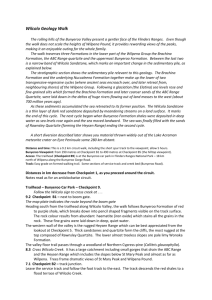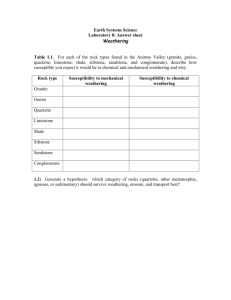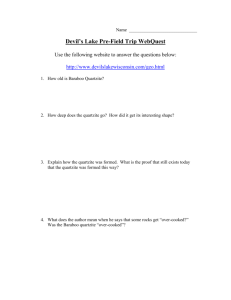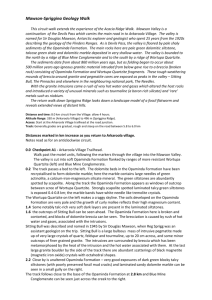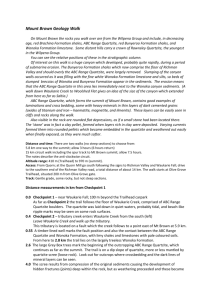DutchmansStern - Walking Trails Support Group
advertisement
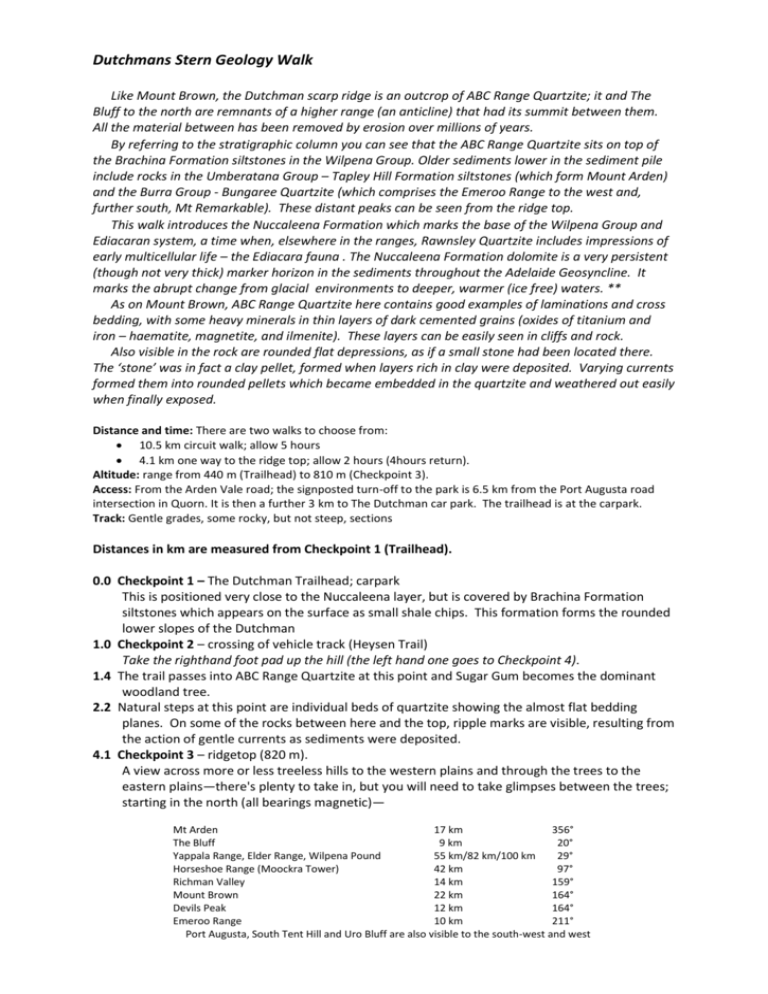
Dutchmans Stern Geology Walk Like Mount Brown, the Dutchman scarp ridge is an outcrop of ABC Range Quartzite; it and The Bluff to the north are remnants of a higher range (an anticline) that had its summit between them. All the material between has been removed by erosion over millions of years. By referring to the stratigraphic column you can see that the ABC Range Quartzite sits on top of the Brachina Formation siltstones in the Wilpena Group. Older sediments lower in the sediment pile include rocks in the Umberatana Group – Tapley Hill Formation siltstones (which form Mount Arden) and the Burra Group - Bungaree Quartzite (which comprises the Emeroo Range to the west and, further south, Mt Remarkable). These distant peaks can be seen from the ridge top. This walk introduces the Nuccaleena Formation which marks the base of the Wilpena Group and Ediacaran system, a time when, elsewhere in the ranges, Rawnsley Quartzite includes impressions of early multicellular life – the Ediacara fauna . The Nuccaleena Formation dolomite is a very persistent (though not very thick) marker horizon in the sediments throughout the Adelaide Geosyncline. It marks the abrupt change from glacial environments to deeper, warmer (ice free) waters. ** As on Mount Brown, ABC Range Quartzite here contains good examples of laminations and cross bedding, with some heavy minerals in thin layers of dark cemented grains (oxides of titanium and iron – haematite, magnetite, and ilmenite). These layers can be easily seen in cliffs and rock. Also visible in the rock are rounded flat depressions, as if a small stone had been located there. The ‘stone’ was in fact a clay pellet, formed when layers rich in clay were deposited. Varying currents formed them into rounded pellets which became embedded in the quartzite and weathered out easily when finally exposed. Distance and time: There are two walks to choose from: 10.5 km circuit walk; allow 5 hours 4.1 km one way to the ridge top; allow 2 hours (4hours return). Altitude: range from 440 m (Trailhead) to 810 m (Checkpoint 3). Access: From the Arden Vale road; the signposted turn-off to the park is 6.5 km from the Port Augusta road intersection in Quorn. It is then a further 3 km to The Dutchman car park. The trailhead is at the carpark. Track: Gentle grades, some rocky, but not steep, sections Distances in km are measured from Checkpoint 1 (Trailhead). 0.0 Checkpoint 1 – The Dutchman Trailhead; carpark This is positioned very close to the Nuccaleena layer, but is covered by Brachina Formation siltstones which appears on the surface as small shale chips. This formation forms the rounded lower slopes of the Dutchman 1.0 Checkpoint 2 – crossing of vehicle track (Heysen Trail) Take the righthand foot pad up the hill (the left hand one goes to Checkpoint 4). 1.4 The trail passes into ABC Range Quartzite at this point and Sugar Gum becomes the dominant woodland tree. 2.2 Natural steps at this point are individual beds of quartzite showing the almost flat bedding planes. On some of the rocks between here and the top, ripple marks are visible, resulting from the action of gentle currents as sediments were deposited. 4.1 Checkpoint 3 – ridgetop (820 m). A view across more or less treeless hills to the western plains and through the trees to the eastern plains—there's plenty to take in, but you will need to take glimpses between the trees; starting in the north (all bearings magnetic)— Mt Arden 17 km 356° The Bluff 9 km 20° Yappala Range, Elder Range, Wilpena Pound 55 km/82 km/100 km 29° Horseshoe Range (Moockra Tower) 42 km 97° Richman Valley 14 km 159° Mount Brown 22 km 164° Devils Peak 12 km 164° Emeroo Range 10 km 211° Port Augusta, South Tent Hill and Uro Bluff are also visible to the south-west and west The hills to the west are layers below the ABC Range Quartzite. The bare hills extending west from the base of the Dutchmans Stern are Umberatana Group siltstones, limy shales, fine grained sandstones and limestones of the Tapley Hill Formation. They extend north to the bare slopes of Mt Arden. Below these siltstones, is Skilogallee Dolomite of the older Burra Group, exposed as pale coloured hills with scrubby vegetation. Beyond these again Bungaree Quartzite is exposed in the Emeroo Range to the SSW, and the distant Mt Remarkable visible to the south just beyond Checkpoint 3 is also Bungaree Quartzite. To the north can be seen as indicated above, the Yappala Range, Elder Range and Wilpena Pound all high points composed of Rawnsley Quartzite, the youngest rock unit in the Wilpena Group. A look at the stratigraphic column would clarify the rock sequence. 4.4 The trail continues around the head of Stony Creek through Drooping Sheoak and Sugar Gum woodland, eventually taking you along the northern side of a gorge with colourful red/golden faces of ABC Range quartzite mantled with scree — you may see Yellow-footed Rock Wallabies here. 7.8 Abundant fragments of Brachina Formation siltstones appear on the track and the large Sugar Gums are replaced by smaller Blue Gums. Take the narrow trail from Checkpoint 4 to return to Checkpoint 2; the characteristic small flat rock fragments of Brachina Formation** siltstones continue to the trailhead. 10.5 Checkpoint 1 – The Dutchman Trailhead; carpark. ** Below the siltstones lies the Nuccaleena Formation, a dolomite which consistently crops out along the length of the Flinders Ranges. It is a cream coloured layer which is the base of the Wilpena Group. From the boom gate near the homestead follow a small creek past the clothes hoist for about 100 metres, slightly east of north. Under a large gum tree is a buff dolomite sill of the Nuccaleena Formation (30–40 cm deep) which crosses the little creek. A metre or two further down, the underlying brick red sandstone and mudstone of the Elatina Formation, is clearly exposed in the creek bed. Glacial tillite of the Elatina Formation is well represented in the Flinders Ranges National Park. The Nuccaleena Formation sediments which were laid down in calm deep water mark an abrupt change from the glacial period of the Elatina Formation, 600 million years ago. Text prepared from field notes supplied by Nick Langsford GLOSSARY OF GEOLOGICAL TERMS For composition of different rock Formations and Groups, see Stratigraphic Column. Adelaide Geosyncline A deep, subsiding trough into which, over about 350 million years, material eroded from adjacent land masses was deposited. anticline A convex upwards fold. The limbs of the fold may dip only a few degrees – a gentle anticline; or be very steep – a tight anticline. bedding, layers, interbedding Bedding is the original surface on which successive layers of sediments were deposited. Originally these were essentially horizontal. cross bedding Where sediment layers are at an angle to the main stratification, often outlined by dark heavy minerals. dolomite Rock that is largely composed of the dolomite mineral, CaMg(CO3)2 Ediacaran Period, system; Ediacaran Golden Spike The Ediacaran Period (1000 million years ago to 543 million years ago) contains evidence of the first multicellular animals to occur on Earth about 560 million years ago; their fossils are impressions of soft-bodied organisms. The base of the Period is physically defined by a bronze spike at the base of the Nuccaleena Formation in Enorama Creek, in the Flinders Ranges National Park, where there is the Golden Spike marker. Formation A sedimentary or volcanic rock unit which can be physically mapped and defined by features observed in the field. glacial Pertaining to formation by processes involving lots of ice. Group A unit which includes two or more Formations of usually sedimentary rocks. haematite Dark grey iron oxide; when scratched it shows a red streak. Not magnetic. Haematite in the Flinders Ranges commonly has a shiny mica-like structure and is called specularite. ilmenite Iron-titanium oxide; dark to shiny grey. Weakly magnetic, no red streak. iron A metallic element, Fe. An important industrial commodity. laminations, laminated Thin, regularly banded layers of sediment; almost always reflects bedding. limestone Sedimentary rock mainly made up of calcium carbonate, CaCO3 magnetite Magnetic iron oxide. mudstones Rocks made up largely of very fine grains, mainly clays – very similar to shales. A rock which once was mud. outcrop Exposure of rock layers protruding through the overlying soil and debris. quartz The most common crustal mineral, silicon dioxide, SiO2 quartzite A rock which was originally quartz sandstone which has been heated or compressed sufficiently to fuse the grains together, producing a tough resistant rock. ripple marks Sedimentary structures formed on sandy beaches by wave or current action. Very common in sandstones and on present day beaches. Has the appearance of corrugated iron. sandstone A rock made of sand – generally largely quartz sand. scarp, escarpment Cliff or steep slope, often the result of fault movements. scree Broken rock which accumulates along the foot of, and on, steep slopes. siltstone A rock composed of silt-sized (less than 0.1 mm) mineral grains, usually mainly quartz. tillite Rock formed by glacial activity, containing a very wide range of grain sizes, usually including some large fragments, obviously not locally derived, known as erratics. titanium A metallic element, Ti; a component of ilmenite.
